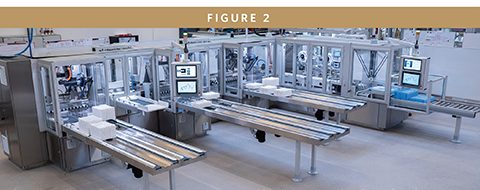Issue:May 2021
INJECTABLES MANUFACTURING - Manufacturing Injectable Devices: Why Modern Means Modular
INTRODUCTION
If steadily emerging trends in the parenteral pharmaceuticals landscape have taught us anything, it is this: one injectable device most certainly does not fit all. Without innovation, patients would find themselves… well, stuck. Today’s drug delivery devices must be more mobile, less intrusive, and simpler than ever before – all while remaining cost competitive.

With modular manufacturing, the goal is to produce equipment solutions that can repeat what typically requires repeating while still remaining flexible for more customized capabilities.
Several factors are driving this. For starters, more and more treatments are moving from the hospital to the home, which saves costs for healthcare providers while increasing patient comfort. Already a trend leading into 2020, this push toward at-home healthcare has only been exacerbated by the COVID-19 pandemic, when hospitals themselves can be dangerous environments for patient treatment.
Meanwhile, over the past several years, the pharma industry has seen a steadily-building trend – one in which the demand for injectables has been consistently growing. Much of this is attributed to the increase in chronic diseases that often require consistent self-administration to ensure proper treatment. The most prominent of these is diabetes, which has long been a problem in the developed world and is now becoming more widespread in developing, large-population nations like India and China. Other instances in which self-administration of injectables come into play are the growing niche of targeted small batch and even personalized medicines, including oncological formulations and certain biologics.
SELF-INJECTION MEANS CUSTOMIZATION
With injectables moving more and more from hospital to home, the need for user-friendly injectable devices becomes clear. As such, it is not surprising that pen devices and auto-injectors have become exceedingly popular, as they deliver drugs efficiently while mitigating the typical risks associated with self-administration via syringes. These risks include incorrect dosing, device misuse, heightened discomfort, and from an adherence standpoint, greater potential for regimen discontinuation.
For pharma companies to continue staying cutting edge and cost competitive, these shifting end-user trends will necessitate a “managing backward” approach to manufacturing optimization. Starting with the unalterable result – injectables will increasingly be both customized and self-administered, whether we want them to be or not – this should, for efficiency’s sake, affect the process stretching all the way back to inception: the design, engineering, and production of the assembly line equipment tasked with manufacturing devices such as auto-injectors or pen injectors. Increasingly in this growing genre, custom-designed equipment, automation, flexible and scalable manufacturing lines, and alternative manufacturing approaches will be critical to achieving timely, successful product launches.
From an infrastructure investment standpoint, the equation is simple: More customized medicines delivered via a broader array of injection devices means a premium is placed on equipment flexibility and modularity.
Although many injector types have similar components, their designs vary significantly in terms of size, material, and shape. This is a major production challenge, especially for contract manufacturing organizations that cater to pharmaceutical customers around the world. The variety of shapes, sizes, components, configurations, and other variables are too exponential to calculate.
Like the pen injectors and auto-injectors themselves, the equipment-centric solution to this conundrum is multifaceted. To keep up with the needs of modern combination products, assembly machinery needs to check a number of boxes.
The first is fast format changeover, which allows manufacturers to expediently handle different formats (pens with variations) and save on costly downtime. The other two are flexibility and scalability. Injection devices assembly is Exhibit A as to why a viable, future-ready pharma production process must embrace and exhibit the ability to adapt to changes in product volumes, demand, and sub-categorical issues like target audience differentiation. Flexible equipment enables manufacturers to meet production variations, or handle even different devices on the same line, ideally eliminating the need for an entirely separate line configuration. Further, it allows reduced CAPEX investments and achieve shorter time to market. To accommodate planned or sudden scale-up processes, the equipment should be scalable and “future-proof,” designed in a manner that allows additional modules to meet increased volumes.
Another factor is automation, which at first glance may seem to contradict the need for smaller batches and customizable delivery devices. Injectables manufacturing increasingly involves a push-pull in which, while lower commercial production volumes are commonly required, manufacturers also must be capable of efficiently switching gears to more far-reaching, wider-scale production efforts. Furthermore, even when batches will remain on the smaller side indefinitely, automating certain processes – for example, tool-free changeover – can reduce human intervention and further decrease production downtime.
In both cases, the mission-critical ability to proficiently pivot is where automation and robotics come into play. At this stage, the common denominators in which automation becomes valuable are reliability, precision, repeatability, and process optimization. The goal is to incorporate these elements at the very inception of the development process, allowing for flexibility to test multiple solutions at a low scale of production and, as the process evolves, have an “automation foundation” in place to expeditiously increase output. The more and the earlier a manufacturer can automate, the more efficient the ramp-up process is likely to progress.
In a landscape where each unique project increasingly requires an equally unique solution complete with its own development and investment schedule – again, one largely devoid of “off-the-shelf” options – a push toward platform-level solutions is underway. This initiative has allowed efficiency-minded companies to pre-configure many elements of an automation line, as part of “preplanning” the process for progressing projects from early R&D through clinical trials and wider production, however large the in-market batches.

When one size doesn’t fit all, the best solutions are rearrangeable solutions – ones that align with modern, mandated assembly line versatility.
BUILDING PRODUCTION SUCCESS FROM THE FOUNDATION UP
When one size doesn’t fit all, the best solutions are rearrangeable solutions – ones that align with modern, mandated assembly line versatility. Simply put: if one production line doesn’t fit all… then you must have the building blocks to configure a broad array of them, depending on project-specific needs. Combined with transport platforms and process modules that help streamline production planning and workflow from initial prototyping to full-scale production, this modular approach will help more pharma manufacturers meet an already-dizzying array of specialized injectables needs now and into the future.
From an equipment aspect, modularity is the primary prerequisite for flexibility and scalability. Increasingly, pharma manufacturers will favor machinery vendors capable of building equipment solutions that are simultaneously tailor-made and agnostic; in other words, lines whose current setup is ideal for the project at hand but reconfigurable to address inevitably shifting needs. This points squarely toward lines that can be efficiently adjusted to address tomorrow’s often ill-defined needs and easily reconfigured for similar projects – all while offering required levels of customization.
To enhance speed-to-market, modular line assemblies – such as those developed by Stevanato Group – can comprise a range of customizable platforms and modules aligned with commonalities across a wide array of projects. The goal is to produce equipment solutions that can repeat what typically requires repeating while still remaining flexible for more customized capabilities.
VIEW FROM THE FACTORY FLOOR
Here’s what this looks like on an everyday basis. At a project’s inception, a manufacturer would typically commence the prototyping phase with a benchtop, then increase production at an early stage by multiplying benchtops and operators – generally one person per benchtop. As an alternative approach, it is advisable to develop a semi-automatic pilot line, which reduces risks related to human intervention and, because it makes the overall process more automated, offers inherent scale-up advantages. In this scenario, an initial investment mitigates risks for future steps as the same technologies are being utilized for both the pilot lines and eventual large-scale, fully automatic line.
Among other benefits, this approach minimizes risks through early debugging and the ability to add scale without the need to re-invent or completely reconfigure the assembly processes.
As the production stages progress, each platform has an increasing range of available modules that can perform assembly, inspection, labeling, and packaging processes. This modular approach enables forward-thinking equipment providers to rapidly engineer tailor-made solutions that deliver consistent performance, high-quality standards, and proven reliability when scaling-up to higher volumes… all built on a consistent, proven foundation. This provides opportunities for greater flexibility to adjust to new device configurations, different device formats, or production requirements.
The benefits found by realizing optimized, modular automation are many. The validation timeframe can be reduced – hastening speed to market – and technology-validated processes become significantly simpler, mitigating any associated risks. Modularly is also, by its very nature, synergy-centric; it encourages engineering and production teams to work in harmony by planning, in parallel, for near-term and longer-range scaling needs.
This building block approach brings another benefit: an inherent ability to grow a line in direct alignment with the production phase. Once each process is validated, manufacturers can proceed from the current automation level to the next one, easing a rapid scale-up. In addition, by utilizing assembly operations with the same module from benchtop platform through large-scale industrial line, these validation processes are minimized both individually and collectively.
Revisiting the speed-to-market aspect, this multi-stage mindset helps expedite the overall process by performing stability or clinical studies in tandem with planning for future scale up. These can be accomplished with robotic systems designed for higher volumes, reliability, and flexibility. Here, involving equipment partners with modularity experience from the early stages offers a distinct advantage, since they’ve seen for themselves how initial development work is crucial for establishing early proof of principle and validating the assembly process.

Raffaele Pace is Engineering Vice President of Operations at Stevanato Group, a leading producer of glass primary packaging and provider of integrated capabilities for drug delivery systems. A licensed engineer, Mr. Pace earned his MBA from the Università di Bologna and his Master’s Degree in Mechanical Engineering from Università della Calabria. He has more than 15 years of experience developing complex equipment and line configurations.
Total Page Views: 5311










